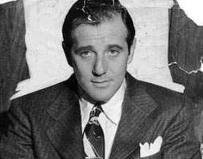Irving Berlin (born Israel Beilin; Yiddish May 11, 1888 – September 22, 1989) was an American composer and lyricist. His music forms a large part of the Great American Songbook. Berlin received numerous honors including an Academy Award, a Grammy Award, and a Tony Award. He also received the Presidential Medal of Freedom from President Gerald R. Ford in 1977. Broadcast journalist Walter Cronkite stated he "helped write the story of this country, capturing the best of who we are and the dreams that shape our lives".
Born in Imperial Russia, Berlin arrived in the United States at the age of five. He published his first song, "Marie from Sunny Italy", in 1907, receiving 33 cents for the publishing rights, and became known as the composer of numerous international hits, starting with 1911's "Alexander's Ragtime Band". He also was an owner of the Music Box Theater on Broadway. For much of his career, Berlin could not read sheet music, and was such a limited piano player that he could only play in the key of F-sharp; he used his custom piano equipped with a transposing lever when he needed to play in keys other than F-sharp. He was known for writing music and lyrics in the American vernacular: uncomplicated, simple and direct, with his stated aim being to "reach the heart of the average American," whom he saw as the "real soul of the country".
He wrote hundreds of songs, many becoming major hits, which made him famous before he turned thirty. During his 60-year career he wrote an estimated 1,500 songs, including the scores for 20 original Broadway shows and 15 original Hollywood films, with his songs nominated eight times for Academy Awards. Many songs became popular themes and anthems, including "Alexander's Ragtime Band", "Blue Skies", "Easter Parade", "Puttin' on the Ritz", "Cheek to Cheek", "White Christmas", "Happy Holiday", "Anything You Can Do (I Can Do Better)", and "There's No Business Like Show Business". His Broadway musical This Is the Army (1942) was adapted into the 1943 film of the same name.
Berlin's songs have reached the top of the US charts 25 times and have been extensively re-recorded by numerous singers. Berlin died in 1989 at the age of 101. Composer Douglas Moore sets Berlin apart from all other contemporary songwriters, and includes him instead with Stephen Foster, Walt Whitman, and Carl Sandburg, as a "great American minstrel"—someone who has "caught and immortalized in his songs what we say, what we think about, and what we believe." Composer George Gershwin called him "the greatest songwriter that has ever lived",: 117 and composer Jerome Kern concluded that "Irving Berlin has no place in American music—he is American music."
"God Bless America" (1938)
The song was written by Berlin twenty years earlier, but he filed it away until 1938 when Kate Smith needed a patriotic song to mark the 20th anniversary of Armistice Day, celebrating the end of World War I. Its release near the end of the Depression, which had by then gone on for nine years, enshrined a "strain of official patriotism intertwined with a religious faith that runs deep in the American psyche," stated The New York Times.
Berlin's daughter, Mary Ellin Barrett, states that the song was actually "very personal" for her father, and was intended as an expression of his deep gratitude to the nation for merely "allowing" him, an immigrant raised in poverty, to become a successful songwriter. "To me," said Berlin, "'God Bless America' was not just a song but an expression of my feeling toward the country to which I owe what I have and what I am." The Economist magazine writes that "Berlin was producing a deep-felt paean to the country that had given him what he would have said was everything."
It quickly became a second national anthem after America entered World War II a few years later. Over the decades it has earned millions for the Boy Scouts and Girl Scouts, to whom Berlin assigned all royalties. In 1954, Berlin received a special Congressional Gold Medal from President Dwight D. Eisenhower for contributing the song.
The song was heard after September 11, 2001, as U.S. senators and congressmen stood on the capitol steps and sang it after the terrorist attacks on the World Trade Center. It is often played by sports teams such as major league baseball. The Philadelphia Flyers hockey team started playing it before crucial contests. When the 1980 U.S. Olympic hockey team pulled off the "greatest upset in sports history," referred to as the "Miracle on Ice", the players spontaneously sang it as Americans were overcome by patriotism.
Awards and honors
- Academy Award for Best Original Song in 1943 for "White Christmas" in Holiday Inn.
- US Army Medal of Merit from General George Marshall at the direction of President Harry S. Truman.
- Tony Award in 1951 for Best Score for the musical Call Me Madam.
- Congressional Gold Medal in 1954 from President Dwight D. Eisenhower for contributing many patriotic songs, including "God Bless America".
- SERVES
- 4
- COOK TIME
- 30 Min
This Sausage, Pepper, and Onion Sandwich is perfect any time of the year, whether we grill or pan-fry it. Close your eyes, wash it down with your favorite bubbly beverage, and you'll be back at the state fair all over again. And this time you won't have to pay for parking!
- 1/4 cup vegetable oil
- 2 green bell peppers, cut into 1/2-inch strips
- 2 red bell peppers, cut into 1/2-inch strips
- 1 large onion, cut into 1/4-inch slices
- 1/2 teaspoon salt
- 1 pound hot Italian rope sausage, cut into 2-inch lengths
- 1/4 cup beer (optional)
- 4 hoagie rolls, split
- In a large skillet over medium heat, heat oil until hot but not smoking.
- Add peppers, onion, and salt; cook 10 minutes, stirring occasionally. Add sausage and beer, if desired, and cook 10 to 15 more minutes, or until sausage is no longer pink in center, stirring occasionally.
- Evenly divide mixture onto hoagie rolls and serve immediately.
National Chocolate Souffle Day celebrates a delightfully delicious dessert on February 28th each year.
The word souffle is the past participle of the French verb souffler, which means “to blow up” or more loosely “puff up” which describes a souffle perfectly. A souffle is a lightly baked cake made with egg yolks and beaten egg whites that are combined with other ingredients to make the dish either a savory main dish or a sweet dessert.
Two essential components make up every souffle.
1. a French creme patisserie base/flavored cream sauce or puree
2. egg whites beaten to a soft peak meringue
A souffle gets its flavor from the base, and the egg whites provide the lift to puff it up. A variety of cheeses, jams, fruits, or chocolates can be baked into the base of the souffle. Many souffle bakers like to puncture the top of the souffle after removing it from the oven. Then they pour mouth-watering sauces onto it, such as chocolate, vanilla, or for a savory flavor cheese and herbs.
HOW TO OBSERVE
Souffles offer an opportunity to show off and invite friends to share in the celebration.
And it's also.......
February 28th, National Tooth Fairy Day, encourages us to take a look back on the history of one of dental care’s little helpers. It’s one way our children develop good dental hygiene.
Like some of the fantastic creations who oversee children, the tooth fairy is a relative newcomer to the world of childhood fantasies.
1920s
In the mid-1920s, fairies were used for all sorts of health education, from bath fairies to fresh air fairies as a way to get kids to remember to eat their vegetables, wash behind their ears and get a good night’s rest. Like toothpaste today advertises fruity flavors and sparkles to get kids excited to brush their teeth, in 1925, it was probably quite a bit more difficult considering the pastes were mostly peroxide and baking soda. One advertisement was for a Fairy Wand Tooth Whitener. This product promised to brush away cigarette and coffee stains. The ad was aimed at both children and adults, we hope!
Then in 1927, Esther Watkins Arnold printed an eight-page playlet for children called The Tooth Fairy. The same year Sir Arthur Conan Doyle “proved” his claim that fairies and gnomes are real and “verified” with pictures of two little girls surrounded by fairies. The world was ripe with imagination and primed to have a tooth fairy to come collect the lost teeth of little boys and girls and leave a coin or two behind.
Arnold’s play began to be performed in schools the following year, and the tooth fairy has been slipping into homes ever since. She (or he) started leaving nickels and dimes under the pillows of sleeping children. Over the years, there have been variations on the theme.
NATIONAL TOOTH FAIRY DAY HISTORY
Children’s author, Katie Davis, created the February 28th observance of National Tooth Fairy Day. While there is also an August 22nd observance, it is interesting to note the two observances are six months apart and the American Dental Association’s recommendation to have cleanings twice annually








